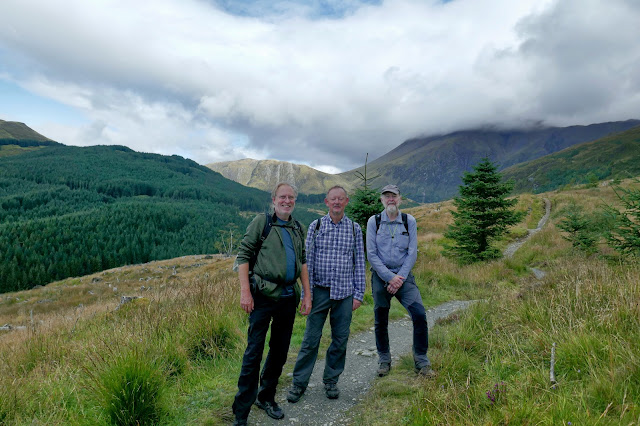At just over 16 miles and with over two thousand feet of elevation gain, today's walk is one of the longer days of our itinerary. It also probably everyone's last day as there's no possibility of breaking the journey and yesterday's itinerary from Kingshouse to Kinlochleven also had no obvious rest stop for those without a tent.
In terrible conditions it is possible to shorten the route by taking the military road as it forks beside the ruins of the old toll house above Lundavra. This route leads more directly to Fort William and shaves three miles from the journey, but that would mean missing out on Glen Nevis and (if we are lucky) a view of Scotland's mightiest mountain.
The Way climbed rapidly out of the town and over a mile we scaled seven hundred feet. Soon we have a view over the Loch and back to the town. Carrying on, we walked along the Lairigmor, or the Big Pass, used for hundreds of years by cattle drovers.
 |
| Jerome on the Lairigmor |
The track is raised above the valley bottom, dry and metalled with small stones and broken rocks. This had been the norm for most of the Way and it was very hard on our feet. The valley itself is between two ridges, the Mamores to the north and the Mam na Gualainn circuit to the south. Having spent the whole journey seemingly in a valley, the ridge walk to the south looked very tempting indeed. For experienced walkers the Mam na Gualainn circuit takes about seven to eight hours to complete. To add it onto our route would have meant an additional three miles of walking and a couple of thousand feet of climbing.
Another alternative would have been to climb over the Mamores. This would be an even bigger challenge but a very exciting one and looking at the OS map I can see several possible routes for heroes using some of the paths of the 'Ring of Steall' as it is known.
The valley was easy in comparison. The way was so peppered with hikers that it would be a challenge to get lost and indeed along the whole route way-marking is excellent. We could have walked the whole distance of the West Highland Way without referring to a map. Not that I recommend that you do.
Also, for those people relying on their mobile phones, the signal was patchy at best and quite often there was none at all. Occassionally in the valleys the GPS signal could be compromised. So it is important to download any maps whenever possible to route-find offline and when walking keep a careful eye on your position, so that it is possible to retrace your steps should you get lost.
The Way carried on eastward for six miles before turning north, still in the valley. Within a mile the path entered a scrubby remnant of Caledonian forest.
 |
| A scrubby bit of Caledonian forest |
In amongst this was a cairn that commemorates a skirmish from the Civil War of 1645. It marks the spot where in the aftermath of the battle of Inverlochy, the MacDonalds of the Montrose Army (and basically Royalists) gave up chasing the rump of the defeated Covenanter (basically Parliamentarian) Argyll forces (some of whom were Campbells).
Less than a mile further on we arrived at the ruins of Blár a´Chaorainn toll house, the half way point of today's walk and where if the weather is bad the military road that forks off to the left offers a quick route to Fort William.
 |
| Lochan Lúnn-Dá-Bhrá and Lundavra farm |
To the east is Lundavra farm and Lochan Lúnn-Dá-Bhrá where a mythical water bull is supposed to occassionally emerge and kill the local cattle. It is also thought to be a place where the Scottish King MacBeth lived, but this might also be mythical water bull as well because there is no supporting evidence for this claim.
 |
| Did I mention that there were one or two other people on the route? |
The Way which had been heading north, meandered eastward and straight ahead the massif of Ben Nevis filled the head of the glen.
 |
| That big lump of cloud is Ben Nevis |
We settled down for a lunch of fruit and biscuits, some of which we'd bought from the Coop in Kinlochleven. This path was only one person wide and a little rougher than the military road. Over a couple of miles it contoured around to enter Glen Nevis under the old vitrified fort of Dun Deardail. Originally built nearly two and a half thousand years ago it has an excellent position, commanding the Glen opposite Ben Nevis. The fort was burnt down around 350 BC which caused the vitrification of some of the stone. Apparently this was the fate of a number of similar aged forts but almost nothing is known about the people who lived here.
 |
| A tantalising view of the summit |
Now, the path descended rapidly into the Glen, revealing the massive bulk of Ben Nevis (yet another caldera volcano) dwarfing the surrounding mountains.
 |
| Cary flanked by Chris and Jerome |
 |
| Jerome, Chris and Duncan and where we are headed next (background) |



Comments
Post a Comment
Leave a comment here